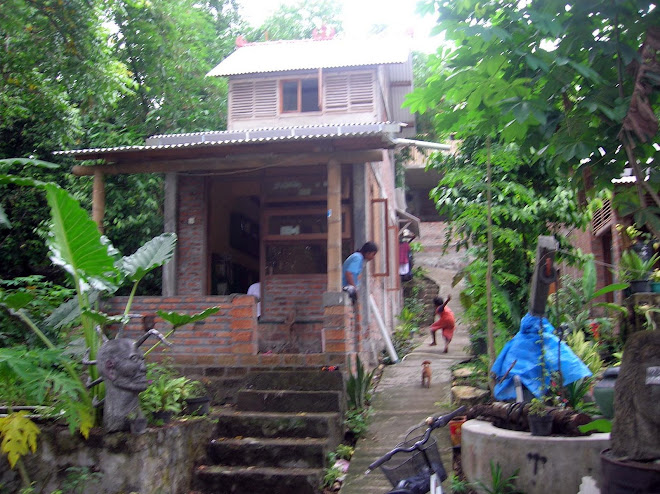


Today in English class we learned to write letters. At first most of the children were hesitant, afraid of making a mistake, but with time and some encouragement they became more willing to try. The biggest thing about learning a new language is being brave to make mistakes. This is
 what I discovered in learning to speak Indonesian as well. It was a big class today, about nine girls and three boys, along with a couple of tag-along younger brothers and sisters. Most of the children live within the same RT; RT in Indonesia stands for a certain section of a village. One village, for example Sembungan where Taring Padi is, is made up of several RT's. Taring Padi is located in RT 02, and most of the kids are either from RT01 and RT 02, with a few from further out.
what I discovered in learning to speak Indonesian as well. It was a big class today, about nine girls and three boys, along with a couple of tag-along younger brothers and sisters. Most of the children live within the same RT; RT in Indonesia stands for a certain section of a village. One village, for example Sembungan where Taring Padi is, is made up of several RT's. Taring Padi is located in RT 02, and most of the kids are either from RT01 and RT 02, with a few from further out.I'll describe Sembungan village for you to make the picture a little more complete. Sembungan village is edged by a river that runs through on the east side- many of the children live alongside the river and swim and fish in it every day. On the north-west side is Gunung Sempu (Sempu Mountain), which has a large Chinese cemetery. To the south is the neighboring village, Kasongan, which is well-known for its ceramics. This also feeds over into
 Sembungan, and many of the nearby neighbors make pots, statues and sculptures out of clay and sell them in local markets. To the north-east of Sembungan, past Kembaran village (where I live), is Madukismo, the sugar factory. Madukismo was started back when the Dutch colonized Indonesia, and it is still active today. During production season (six months out of a year), you can often hear the horn of the factory blowing, see a stream of smoke raising out of its towers into the sky, and find little specs of black ash sprinkled across your house. Sembungan also sports a large open soccer field that the young men play in every evening before sunset and makrib (Islamic call to prayer), a front-yard volleyball/badminton court, a twice-a-week ladies aerobics class, and a local gamelan ensemble. It's a lovely village, with lots of trees, animals and friendly neighbors.
Sembungan, and many of the nearby neighbors make pots, statues and sculptures out of clay and sell them in local markets. To the north-east of Sembungan, past Kembaran village (where I live), is Madukismo, the sugar factory. Madukismo was started back when the Dutch colonized Indonesia, and it is still active today. During production season (six months out of a year), you can often hear the horn of the factory blowing, see a stream of smoke raising out of its towers into the sky, and find little specs of black ash sprinkled across your house. Sembungan also sports a large open soccer field that the young men play in every evening before sunset and makrib (Islamic call to prayer), a front-yard volleyball/badminton court, a twice-a-week ladies aerobics class, and a local gamelan ensemble. It's a lovely village, with lots of trees, animals and friendly neighbors. At the beginning of class the children arrive on their bikes or are dropped off by their parents. They are always bustling with energy, some shy, some playful, many of them bringing the books they borrowed from last week, and always eager
At the beginning of class the children arrive on their bikes or are dropped off by their parents. They are always bustling with energy, some shy, some playful, many of them bringing the books they borrowed from last week, and always eager  to learn.
to learn.






















